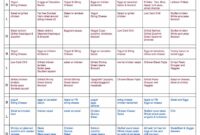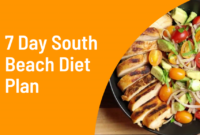South Beach Phase 1 cookies offer a delicious and surprisingly satisfying treat, even while adhering to the dietary restrictions of the South Beach Diet’s initial phase. This guide delves into the creation of these delightful cookies, exploring recipe variations, baking techniques, ingredient substitutions, and serving suggestions. We’ll cover everything from achieving the perfect texture to mastering various flavor profiles, ensuring your South Beach Phase 1 cookies are a culinary success.
Whether you’re a seasoned baker or a kitchen novice, this comprehensive guide provides clear instructions and helpful tips to navigate the nuances of baking low-carb cookies. We’ll explore the science behind the baking process, explaining why certain ingredients and techniques are crucial for optimal results. Get ready to embark on a baking journey that’s both informative and delicious.
South Beach Phase 1 Cookie Recipe Variations
The South Beach Diet Phase 1 focuses on eliminating sugars and processed foods. These cookie variations offer delicious alternatives that adhere to the diet’s strict guidelines, satisfying sweet cravings without compromising the principles of the phase. Each recipe prioritizes low-carb, high-protein ingredients to promote satiety and maintain blood sugar stability. Remember to always check nutrition labels for the specific ingredients you use, as values can vary slightly between brands.
South Beach Phase 1 Cookie Recipe Variations: Detailed Descriptions
This section details three distinct flavor profiles for South Beach Phase 1 cookies, providing ingredient lists, preparation instructions (simplified for brevity), and nutritional information (per cookie, approximate values). These values are estimates and may vary based on specific ingredients and portion sizes.
Chocolate Peanut Butter Cookies
These cookies combine the richness of dark chocolate with the satisfying creaminess of peanut butter. The sweetness is subtly provided by a touch of stevia or another suitable sugar substitute.
Ingredients: 1 cup almond flour, 1/4 cup unsweetened cocoa powder, 1/4 cup peanut butter (natural, no added sugar), 2 large eggs, 1/4 cup erythritol or stevia to taste, 1 teaspoon vanilla extract.
Instructions: Preheat oven to 350°F (175°C). Combine all ingredients in a bowl and mix thoroughly. Drop by rounded tablespoons onto a baking sheet lined with parchment paper. Bake for 10-12 minutes, or until edges are set. Let cool completely.
Nutritional Information (per cookie, approximate): Calories: 120, Fat: 8g, Protein: 4g, Carbohydrates: 6g.
Almond Coconut Cookies
This variation offers a delightful combination of almond and coconut flavors, providing a naturally sweet and satisfying treat. The use of almond flour ensures a low-carb base.
Ingredients: 1 cup almond flour, 1/2 cup unsweetened shredded coconut, 2 large eggs, 2 tablespoons coconut oil (melted), 1/4 cup erythritol or stevia to taste, 1/2 teaspoon almond extract.
Instructions: Preheat oven to 350°F (175°C). Combine all ingredients in a bowl and mix well. Form into small balls and flatten slightly on a baking sheet lined with parchment paper. Bake for 10-12 minutes, or until lightly golden. Let cool completely.
Nutritional Information (per cookie, approximate): Calories: 100, Fat: 7g, Protein: 3g, Carbohydrates: 5g.
Oat Fiber Cookies
This recipe utilizes oat fiber for a slightly chewier texture and a subtle oat flavor. It’s a good option for those who miss the texture of traditional oatmeal cookies.
Ingredients: 1 cup oat fiber, 1/4 cup almond flour, 2 large eggs, 2 tablespoons unsweetened applesauce, 1/4 cup erythritol or stevia to taste, 1 teaspoon cinnamon.
Instructions: Preheat oven to 350°F (175°C). Combine all ingredients in a bowl and mix until well combined. Drop by rounded tablespoons onto a baking sheet lined with parchment paper. Bake for 12-15 minutes, or until lightly browned. Let cool completely.
Nutritional Information (per cookie, approximate): Calories: 90, Fat: 4g, Protein: 3g, Carbohydrates: 12g (mostly fiber).
Ingredient Comparison Table
The following table compares the ingredients across the three cookie variations:
| Name | Quantity | Unit | Notes |
|---|---|---|---|
| Almond Flour | 1 cup | cup | Used in all three recipes |
| Unsweetened Cocoa Powder | 1/4 cup | cup | Chocolate Peanut Butter Cookies only |
| Peanut Butter (Natural, No Sugar Added) | 1/4 cup | cup | Chocolate Peanut Butter Cookies only |
| Unsweetened Shredded Coconut | 1/2 cup | cup | Almond Coconut Cookies only |
| Coconut Oil (Melted) | 2 tbsp | tbsp | Almond Coconut Cookies only |
| Oat Fiber | 1 cup | cup | Oat Fiber Cookies only |
| Unsweetened Applesauce | 2 tbsp | tbsp | Oat Fiber Cookies only |
| Large Eggs | 2 | ea | Used in all three recipes |
| Erythritol/Stevia | 1/4 cup approx | cup | Adjust to taste in all recipes |
| Vanilla Extract | 1 tsp | tsp | Chocolate Peanut Butter Cookies only |
| Almond Extract | 1/2 tsp | tsp | Almond Coconut Cookies only |
| Cinnamon | 1 tsp | tsp | Oat Fiber Cookies only |
Baking Techniques for South Beach Phase 1 Cookies
Mastering the art of baking South Beach Phase 1 cookies involves understanding the interplay of temperature, time, and precise ingredient measurements. These cookies, designed for a lower-carbohydrate diet, require careful attention to detail to achieve the desired texture and flavor. Slight variations in technique can significantly impact the final product.
Optimal baking temperature and time for South Beach Phase 1 cookies depend on several factors, including the specific recipe used, the size and type of cookie, and the characteristics of your oven. Generally, a temperature range of 350°F (175°C) to 375°F (190°C) is suitable. Baking times typically range from 8 to 12 minutes, but close monitoring is crucial. Thicker cookies will require longer baking times than thinner ones. Ovens vary in their heating consistency; some may run hotter or cooler than others. It’s advisable to check for doneness starting at the lower end of the recommended time, and then checking every minute thereafter. A toothpick inserted into the center should come out with just a few moist crumbs attached, indicating the cookies are baked through.
Ingredient Measurement and Mixing Techniques
Accurate ingredient measurement is paramount in South Beach Phase 1 cookie baking. Using a kitchen scale for measuring dry ingredients like almond flour and sweeteners ensures consistency and prevents overly dry or moist cookies. Volume measurements can be less precise. For wet ingredients like eggs and oil, using measuring cups and spoons is acceptable, but ensuring accuracy is still important. The mixing technique should be gentle to avoid overmixing, which can lead to tough cookies. Creaming together the fats and sweeteners before adding the wet and dry ingredients is essential for achieving a tender crumb. Overmixing develops the gluten in the almond flour, resulting in a denser texture. The batter should be just combined; a few lumps are acceptable.
Troubleshooting Common Baking Problems
Dry cookies are often a result of insufficient moisture in the batter or overbaking. Adding a tablespoon or two of unsweetened applesauce or mashed banana can increase moisture. Reducing baking time by a minute or two can also help. Burnt edges usually indicate the oven temperature is too high or the cookies are baking too close to the oven’s heating element. Using a baking sheet with a lower shelf position can prevent burning. If your oven tends to run hot, reducing the temperature by 25°F (15°C) might be necessary. Conversely, if cookies are underbaked, extend the baking time by a minute or two, checking frequently for doneness. Using a timer and keeping a close eye on the cookies throughout the baking process is essential to achieving the perfect results.
Ingredient Substitutions in South Beach Phase 1 Cookies
Adapting South Beach Phase 1 cookie recipes often involves substituting ingredients to meet dietary needs or personal preferences. Understanding the impact of these substitutions on both taste and texture is crucial for achieving a successful outcome. This section explores viable alternatives for common components, highlighting their effects on the final product.
Substituting ingredients in South Beach Phase 1 cookies requires careful consideration, as the goal is to maintain the low-carbohydrate, high-protein nature of the diet while still producing delicious and satisfying cookies. Incorrect substitutions can significantly alter the texture and flavor profile, resulting in a less desirable end product. Therefore, understanding the role of each ingredient is essential before making any replacements.
Sweetener Alternatives
Different sweeteners impact the final product differently. Stevia, known for its intense sweetness, might require less volume than other alternatives, potentially affecting the overall moisture content. Erythritol, while less sweet, often contributes a cooling sensation and might require adjustments to the recipe’s liquid content. Monk fruit, another popular option, offers a clean sweetness but can sometimes have a slight aftertaste that may need to be balanced with other flavors. Experimentation is key to finding the perfect balance for your taste preferences.
Flour Alternatives
Almond flour is a common substitute for traditional wheat flour in South Beach Phase 1 cookies, contributing a slightly nutty flavor and a denser texture. Coconut flour, while offering a distinct coconut taste, absorbs significantly more liquid than almond flour, requiring careful recipe adjustments to avoid a dry or crumbly outcome. Alternatively, oat flour (ensure it’s certified gluten-free if needed) provides a slightly softer texture compared to almond flour, but its carbohydrate content should be considered carefully within the context of the South Beach diet.
Fat Alternatives
Butter is often used in South Beach Phase 1 cookies for its flavor and texture. However, substitutions can be made. Coconut oil, for example, adds a distinct coconut flavor and can result in a slightly more dense cookie. Avocado oil, on the other hand, offers a milder flavor and a slightly softer texture. Unsweetened applesauce can also be used to replace a portion of the fat, contributing moisture and a slight sweetness. However, it will alter the texture, leading to a more cake-like consistency.
Ingredient Substitution Table
| Original Ingredient | Substitute | Impact on Taste | Impact on Texture |
|---|---|---|---|
| Sugar | Stevia | Intensely sweet, may require less volume | Potentially drier, depending on recipe adjustment |
| All-purpose flour | Almond flour | Nutty flavor | Denser, more crumbly |
| Butter | Coconut oil | Adds coconut flavor | Denser, may be slightly more moist |
Serving and Storage Suggestions for South Beach Phase 1 Cookies
Proper serving and storage are crucial for enjoying the deliciousness and nutritional benefits of your South Beach Phase 1 cookies at their best. These cookies, designed to fit within the dietary restrictions of the South Beach Diet’s initial phase, deserve careful handling to maintain their texture and flavor. Following these guidelines will ensure you savor every bite.
These cookies, being lower in carbohydrates and often incorporating nuts and seeds, pair well with a variety of beverages and can be enjoyed at various times throughout the day. Appropriate storage techniques will also prevent spoilage and ensure the cookies remain palatable for an extended period.
Serving Suggestions
South Beach Phase 1 cookies can be enjoyed in a variety of ways, complementing different occasions and preferences. Their slightly denser texture and often nutty flavor profile makes them ideal for accompanying beverages such as coffee or tea. They also serve as a satisfying and healthy snack between meals, providing sustained energy without the sugar crash associated with many traditional cookies. For example, a couple of cookies with a cup of unsweetened almond milk could be a perfect afternoon pick-me-up. Alternatively, a single cookie paired with a strong cup of black coffee could be a satisfying breakfast option.
Storage Recommendations
To maintain the optimal freshness and quality of your South Beach Phase 1 cookies, proper storage is essential. Exposure to air and moisture can lead to staleness and a loss of texture. Storing cookies in an airtight container at room temperature is generally recommended for short-term storage (up to 3-5 days). For longer storage, freezing is the ideal method. Place cookies in a freezer-safe container or bag, ensuring they are well-protected from freezer burn. Frozen cookies can maintain their quality for several weeks, even months, if properly sealed. Remember to thaw them gradually at room temperature before serving.
Best Practices for Serving and Storing South Beach Phase 1 Cookies
- Serve cookies at room temperature for optimal texture and flavor.
- Pair cookies with beverages such as coffee, tea, or unsweetened almond milk.
- Enjoy cookies as a snack between meals or as part of a balanced breakfast.
- Store cookies in an airtight container at room temperature for up to 3-5 days.
- For longer storage (several weeks to months), freeze cookies in a freezer-safe container or bag.
- Thaw frozen cookies gradually at room temperature before serving.
Summary
Mastering the art of South Beach Phase 1 cookies involves understanding the interplay of ingredients and techniques. From choosing the right sweetener to achieving the perfect bake, this guide has provided a roadmap to success. Experiment with different flavor variations, embrace ingredient substitutions, and enjoy the satisfying reward of a delicious, diet-friendly treat. Remember to store your cookies properly to maintain their freshness and savor every bite.




